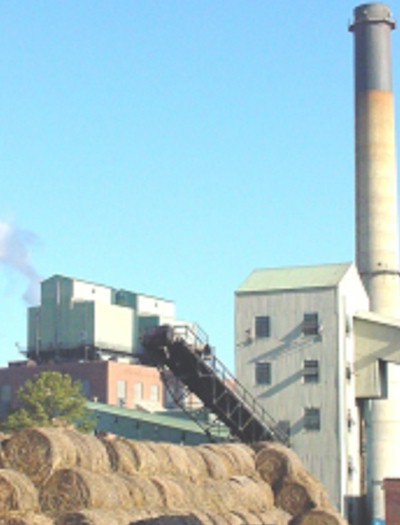Renewable Energy through Co-Firing
Switchgrass in a Coal-Fired Unit
Project Summary
 Switchgrass
is a native prairie grass that is highly productive on marginal farmland. It is
harvested with traditional farm equipment, requires little care, and grows well
in the US southeast. Pilot-scale testing has shown the potential for switchgrass
as a renewable energy source capable of reducing carbon dioxide (CO2) emissions.
When burned with coal in coal-fired plants, studies have also indicated that
sulfur dioxide (SO2), mercury, and perhaps nitrogen oxides (NOx) could be
reduced.
Switchgrass
is a native prairie grass that is highly productive on marginal farmland. It is
harvested with traditional farm equipment, requires little care, and grows well
in the US southeast. Pilot-scale testing has shown the potential for switchgrass
as a renewable energy source capable of reducing carbon dioxide (CO2) emissions.
When burned with coal in coal-fired plants, studies have also indicated that
sulfur dioxide (SO2), mercury, and perhaps nitrogen oxides (NOx) could be
reduced.
To study the potential for switchgrass-based renewable energy, Alabama Power,
and Southern Company, with its partners Southern Research Institute and Auburn
University, designed and constructed a unique handling, processing, and
combustion system for co-firing switchgrass with coal at Alabama Power’s Plant
Gadsden. Extensive tests with this system coupled with the results of
pilot-scale testing at Southern Company’s combustion test facility were used to
understand and optimize the handling, combustion, and efficiency of this
renewable energy system.
For the project, fields of switchgrass were harvested into large round bales.
During six weeks of detailed testing starting in March of 2001, these bales were
chopped and pneumatically conveyed by the new delivery system and into the Plant
Gadsden furnace through specially designed burners. The boiler and unit were
instrumented to measure or calculate many parameters including emissions and
boiler efficiency. Switchgrass loadings of up to 10% by energy displaced were
achieved, with full load grass input at typically 7 to 8 per cent of the input
energy. Switchgrass co-firing was then continued through the summer.
Transport and handling of the grass caused considerable problems, in large
part because the testing was designed to push the unique system to its physical
limits. As a result, much experience and data were obtained on requirements to
reduce risk of future pipe plugging, as well as optimizing energy costs for
tubgrinding and handling the bales.
Environmental advantages with switchgrass co-firing were clearly documented
in the tests. CO2, SO2 and mercury emissions decreased with the introduction of
switchgrass and there was no adverse effect on NOx emissions. Switchgrass
co-firing reduced boiler efficiency by 0.3% to 1.0%, which was considered to be
acceptable considering the higher moisture content of the grass. Modifying
switchgrass storage procedures to decrease absorbed moisture should improve
efficiency results during a three-year, extended evaluation beginning in 2002.
In summary, switchgrass co-firing was tested successfully, and has potential
as a renewable energy source. Future testing will focus on fuel procurement
issues, improved system efficiencies, and long-term impact on slagging and
fouling. Other sources of similar biomass such as local hay, agricultural waste,
and sawdust will also be explored at the facility.
 Switchgrass
is a native prairie grass that is highly productive on marginal farmland. It is
harvested with traditional farm equipment, requires little care, and grows well
in the US southeast. Pilot-scale testing has shown the potential for switchgrass
as a renewable energy source capable of reducing carbon dioxide (CO2) emissions.
When burned with coal in coal-fired plants, studies have also indicated that
sulfur dioxide (SO2), mercury, and perhaps nitrogen oxides (NOx) could be
reduced.
Switchgrass
is a native prairie grass that is highly productive on marginal farmland. It is
harvested with traditional farm equipment, requires little care, and grows well
in the US southeast. Pilot-scale testing has shown the potential for switchgrass
as a renewable energy source capable of reducing carbon dioxide (CO2) emissions.
When burned with coal in coal-fired plants, studies have also indicated that
sulfur dioxide (SO2), mercury, and perhaps nitrogen oxides (NOx) could be
reduced.